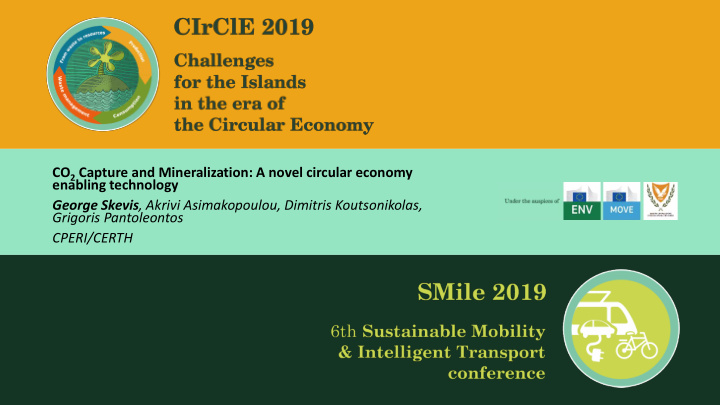



CO 2 Capture and Mineralization: A novel circular economy enabling technology George Skevis , Akrivi Asimakopoulou, Dimitris Koutsonikolas, Grigoris Pantoleontos CPERI/CERTH
Transition to a CO 2 economy – CO 2 as an asset and not as a waste Koutsonikolas et al., International Journal of Energy and Environmental Engineering, (2015) 1-8
Transition to a CO 2 economy – CO 2 as an asset and not as a waste • Full circle recycling of CO 2 to (carbon-neutral) fuels and (carbon-negative) chemicals and minerals using renewable sources • Technological options to overcome unfavourable thermodynamics
What is CO 2 Mineralization • Carbonation technology is based on reacting CO 2 with calcium (Ca) or magnesium (Mg) oxide or silicate to form a solid carbonate mineral structure. These materials can be found either in natural form or in waste streams • The mineralization of CO 2 is an alternative to conventional geological storage through the reaction with matrices containing alkaline-earth metals to form carbonates . • CO 2 mineralization results in permanent storage of CO 2 as a solid , with no need for long term monitoring. • Carbonation reaction can be accelerated by using high CO 2 concentrations and optimized reaction conditions. The reaction is exothermic (releases energy as heat). • Carbonation processes do not need any significant input of renewable energy.
What is CO 2 Mineralization • Direct ex-situ carbonation involving natural sources (single-step reaction, slow kinetics) • Direct carbonation is simple but limited (does not require additional chemicals, “small -scale storage”
What is CO 2 Mineralization • Indirect mineral carbonation route takes place in more than two steps, including (i) extraction of Ca and/or Mg components and (ii) a precipitation reaction step between Ca/Mg and CO 2 in either gaseous or aqueous phases. • Exploitation of industrial waste streams (e.g. steel slag contains up to 60% CaO with significant amounts of Mg and Si) • High purity BUT use of additives (effect on efficiency/sustainability) Slag2PCC : The world’s first mineral carbonation pilot plant test facility that converts steel slag and CO 2 into precipitated calcium carbonate (PCC) utilizing ammonia salt solutions.
Why CO 2 Mineralization – Life Cycle Analysis Ecofys (2017) Assessing the Potential of CO2 Utilisation in the UK CE Delft (2018) Screening LCA for CCU routes connected to CO2 Smart Grid
The RECODE Project www.recodeh2020.eu
Gas-liquid membrane contactors for post-combustion capture and utilization Koutsonikolas, D. et al. (2015), International Journal of Energy and Environmental Hydrophobic membranes Hydrophilic membranes Engineering, 1-8. (Polymeric membranes) (Ceramic membranes) ➢ An immobilized gas-liquid interface is created at the pores mouth where reaction takes place ➢ No dispersion of one phase in the other ➢ Very high and well defined surface areas can be obtained ➢ This mode of operation can be used for direct CO 2 capture from the flue gases! ➢ Easy and modular scale up of the process
Nano-calcium carbonate precipitation 3 structures X-Ray Diffraction (XRD) Diagram-Crystallite Identification
Nano-calcium carbonate for the cement industry • Nano-calcium carbonate partially substitute cement in high-performance concrete. • Addition of nano-CaCO 3 improves flowability and workability of concrete (lubricating effect of nanoparticles) • Reduction in porosity and enhanced pore structure improves mechanical properties (compressive strength) of concrete • Optimum mixing proportion of nano-CaCO 3 at ca. 3-5% (effect of particle size distribution?) 3 structures Camiletti, J. et al., (2013) Magazine of Concrete Research, 65:297-307
Conclusions • CO 2 mineralization is a promising option for flexible and thermodynamically favourable ex-situ carbon utilization and storage. • Novel membrane-based technology offers direct capture and mineralization in a compact unit. • Carbonate production as an enabler of circular economy in energy-intensive industries (e.g. cement). 3 structures
Thank k you fo u for your ur att ttenti tion on gskevis@cperi.certh.gr
Recommend
More recommend